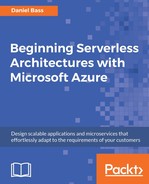If you are operating on a totally greenfield project, everything that we have discussed so far will work perfectly. The full variety of SaaS, PaaS, and IaaS integrations means that your serverless code will happily operate with any set of requirements. Where things tend to get tricky is legacy systems. Whether they are written in a programming language that is no longer supported inside your firm, are monolithic and difficult to extend, or are completely black box, these applications do tend to perform vital business functions and therefore cannot be left out in the cold. If there is an API then integration is straightforward, but sadly there often isn't one. Either a gargantuan development effort needs to be made to replace them or they need to be integrated into the new architecture.
Serverless can come to the rescue for most cases, although there will always be some applications written so uniquely that it's impossible to help them.
First, we'll look at the easiest way that serverless can help. If your app has an API, you can just call it directly; but if there's a lot of development going on with this application, then you may end up replicating a lot of the API calls. If you have an OpenAPI definition, then you can create a custom connector for Logic Apps (and a few other Microsoft services) that allows other developers to use it, as you have been using the Gmail connector (and so on) in Logic Apps.
Secondly, if your application has code that you can change (in other words, if it is open source or written internally), then you can simply add HTTP requests that trigger serverless functions. This will effectively allow you to create events when certain methods are triggered.
